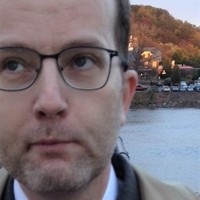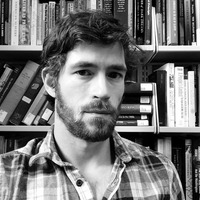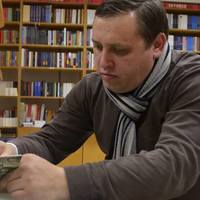Books by Tarik Cyril Amar

In The Paradox of Ukrainian Lviv, Tarik Cyril Amar reveals the local and transnational forces beh... more In The Paradox of Ukrainian Lviv, Tarik Cyril Amar reveals the local and transnational forces behind the twentieth-century transformation of one of East Central Europe's most important multiethnic borderland cities into a Soviet and Ukrainian urban center. Today, Lviv is the modern metropole of the western part of independent Ukraine and a center and symbol of Ukrainian national identity as well as nationalism. Over the last three centuries it has also been part of the Habsburg Empire, interwar Poland, a World War I Russian occupation regime, the Nazi Generalgouvernement, and, until 1991, the Soviet Union.
Lviv's twentieth-century history was marked by great violence, massive population changes, and fundamental transformation. Under Habsburg and Polish rule up to World War II, Lviv was a predominantly Polish city as well as one of the major centers of European Jewish life. Immediately after World War II, Lviv underwent rapid Soviet modernization, bringing further extensive change. Over the postwar period, the city became preponderantly Ukrainian―ethnically, linguistically, and in terms of its residents’ self-perception. Against this background, Amar explains a striking paradox: Soviet rule, which came to Lviv in its most ruthless Stalinist shape and lasted for half a century, left behind the most Ukrainian version of the city in history. In reconstructing this dramatic and profound change, Amar also illuminates the historical background to present-day identities and tensions within Ukraine.
Conference Presentations by Tarik Cyril Amar
Presentation at: History’s War: The Political Uses of WWII
Thursday, May 7, 2015 │10:00 am - 1:30... more Presentation at: History’s War: The Political Uses of WWII
Thursday, May 7, 2015 │10:00 am - 1:30 pm
Location:Johns Hopkins University - SAIS and the Center on Global Interests
Papers by Tarik Cyril Amar

Nationalities papers, Sep 17, 2020
I thank the contributors to this forum for their close reading and detailed responses. I am grate... more I thank the contributors to this forum for their close reading and detailed responses. I am grateful for their work and attention. On the whole, I agree with much in the contributions by Mayhill Fowler, John-Paul Himka, and Serhy Yekelchyk, but not-I should state this clearly-with many of Bohdan Shumylovych's comments. In my response, rather than reiterate points of agreement, I focus on issues that may benefit from further discussion, clarification, or clear disagreement. First, however, I should note that I do not think that these points include all questions that my work could also have addressed if I had had a lifetime to write and triple the word count now usually allotted for first books. Thus, like Shumylovych, I, too, would have liked to write more "about the role of urban space in making Soviet subjects in the city of Lviv; how social or class identities intermingled with national imaginations (but not on the level of elites); how prewar cultural practices remained and helped locals to hybridize newcomers; how media and popular culture from the West and East brought new sounds and fashions in the 1950s; and how pre-1939 local family and gender patterns undermined socialist fantasies of communist colonizers." These are good topics for further research (and I do say some things about some of them). Yet there is only so much a single author can do. I leave further work to my colleagues, especially those in Lviv and Ukraine. Many years ago, when I told the Lviv historian Yaroslav Hrytsak that I planned to work with the local archive of the Communist party, he advised me that such documents were almost useless as they were shot through with too much ideology. I am glad if my work has helped put such non-sequiturs to rest and hope that it helps encourage Ukrainian historians to work more with the rich holdings, especially of the former Communist party archive. In a larger context, I can only join John-Paul Himka in hoping that my work helps pierce the wall that seems to protect some studies of Ukrainian history written in a traditional and conveniently "uncontroversial" vein from contact with the critical approach that has long been called for. The opening of archives after the Soviet collapse (now a generation ago) should have undermined this wall. Resurgent attempts at aggressive nationalist manipulation of narratives, policies, and memories-Ukraine-make its removal, at long last, ever more urgent. Generally, I have to strongly disagree with much of Shumylovych's reading of my book. For example, Shumylovych writes that I "borrowed" the concept of a paradox in Lviv's twentiethcentury development from Martin Åberg, but he also acknowledges that my use of this term (not, therefore, concept) is fundamentally different from Åberg's, as I also make explicit in my book. Rather than "borrow," I explicitly contest and revise. This is, however, a point of minor significance. I have greater concern about Shumylovych's implication that I am not consistent about the key factors or forces changing Lviv. He writes, "according to Amar, Lviv's recent and paradoxical history and character was molded into a modern
Cahiers du monde russe, 2018

Winter 2022 - Narrating Cold Wars
This article addresses a franchise of intelligence films in the former Communist East Germany. Un... more This article addresses a franchise of intelligence films in the former Communist East Germany. Under the general title Das unsichtbare Visier—The Invisible Visor—they were produced for television and very popular. In general, the Cold War East produced a rich array of its own intelligence heroes, which cannot be reduced to mere derivatives of Western models. Yet there were commonalities and interactions across Cold War divides. One of these common features that Visier shared with many intelligence films globally was the depiction of abroad as both an “invisible front” of dangers and temptations and an exciting realm of adventure and consumption. Visier could not but also be a fantasy about East German citizens encountering, withstanding, and also enjoying the dangers and temptations of the Western Cold War Other. This included their facing two peculiar challenges: a degree of international mobility unlike anything the vast majority of ordinary East Germans could experience and the W...

Jahrbücher für Geschichte Osteuropas
Sovietization with a Woman's Face: Gender and the Social Imaginary of Sovietness in Weste... more Sovietization with a Woman's Face: Gender and the Social Imaginary of Sovietness in Western Ukraine Through a close reading and contextualization of major examples of official cultural production in post-1939 Western Ukraine, a key part of the " Soviet West " , this article reconstructs the interplay in officially sanctioned popular culture of three constitutive elements of Sovietness: the transfer of Soviet modernity, the social imaginary of gender with special regard to femininity, and the continual delimitation against defining Others. It uses the self-articulating practices of Sovietization as a window on a specific and important section of the Soviet social imaginary – how the making of the New Woman was imagined as well as her contribution to spreading Sovietness. The Soviet imaginary of a modernity mission in a backward West had a prominent place for women. On the whole, its inherent univer-salism prevailed: what exemplary women were meant to do in the new Soviet West was not principally new but followed patterns congealing in the 1930s and developing further during the German-Soviet War. At the most fundamental level, this political-cultural outcome was not contingent but reflected the fact that Sovietization was a core, not an auxiliary, element of Sovietness: being Soviet included the potential for spreading Sovietness. A new borderland could and would produce variation but not rupture.
Journal of Contemporary History, 2020

Global Storytelling: Journal of Digital and Moving Images, 2023
This article addresses a franchise of intelligence films in the former Communist East Germany. Un... more This article addresses a franchise of intelligence films in the former Communist East Germany. Under the general title Das unsichtbare Visier—The Invisible Visor—they were produced for television and very popular. In general, the Cold War East produced a rich array of its own intelligence heroes, which cannot be reduced to mere derivatives of Western models. Yet there were commonalities and interactions across Cold War divides. One of these common features that Visier shared with many intelligence films globally was the depiction of abroad as both an “invisible front” of dangers and temptations and an exciting realm of adventure and consumption. Visier could not but also be a fantasy about East German citizens encountering, withstanding, and also enjoying the dangers and temptations of the Western Cold War Other. This included their facing two peculiar challenges: a degree of international mobility unlike anything the vast majority of ordinary East Germans could experience and the West’s consumerism. Visier addressed both these issues through what we could describe as an essentially playful—and dis-playful—practical cosmopolitanism. A careful look reveals Visier as a rich artifact of Cold War popular culture, with complex messages. The image of the heroic East German agent included a running comment of compensatory wish fulfillment. Here were ideal East German citizens doing their duty and yet also getting a fair slice of the capitalist good life abroad that most of their compatriots could not reach. They also consistently punched above their weight vicariously for East Germany as a whole. Like Britain’s James Bond, these were agents of an at-best middling power doing major things in the world at large. And finally, perhaps most satisfyingly of all, they turned into gentle, benevolent guardian angels of hapless West German cousins, neatly reversing West Germany’s claims of superiority.
The English Historical Review, 2017
It is, unfortunately, unlikely that I will remember and properly acknowledge all the many individ... more It is, unfortunately, unlikely that I will remember and properly acknowledge all the many individuals and institutions that have helped me write this book, and I offer my apologies to those I inadvertently omit. Special thanks are due to my adviser
The American Historical Review, 2017

Nationalities Papers, 2020
I thank the contributors to this forum for their close reading and detailed responses. I am grate... more I thank the contributors to this forum for their close reading and detailed responses. I am grateful for their work and attention. On the whole, I agree with much in the contributions by Mayhill Fowler, John-Paul Himka, and Serhy Yekelchyk, but not-I should state this clearly-with many of Bohdan Shumylovych's comments. In my response, rather than reiterate points of agreement, I focus on issues that may benefit from further discussion, clarification, or clear disagreement. First, however, I should note that I do not think that these points include all questions that my work could also have addressed if I had had a lifetime to write and triple the word count now usually allotted for first books. Thus, like Shumylovych, I, too, would have liked to write more "about the role of urban space in making Soviet subjects in the city of Lviv; how social or class identities intermingled with national imaginations (but not on the level of elites); how prewar cultural practices remained and helped locals to hybridize newcomers; how media and popular culture from the West and East brought new sounds and fashions in the 1950s; and how pre-1939 local family and gender patterns undermined socialist fantasies of communist colonizers." These are good topics for further research (and I do say some things about some of them). Yet there is only so much a single author can do. I leave further work to my colleagues, especially those in Lviv and Ukraine. Many years ago, when I told the Lviv historian Yaroslav Hrytsak that I planned to work with the local archive of the Communist party, he advised me that such documents were almost useless as they were shot through with too much ideology. I am glad if my work has helped put such non-sequiturs to rest and hope that it helps encourage Ukrainian historians to work more with the rich holdings, especially of the former Communist party archive. In a larger context, I can only join John-Paul Himka in hoping that my work helps pierce the wall that seems to protect some studies of Ukrainian history written in a traditional and conveniently "uncontroversial" vein from contact with the critical approach that has long been called for. The opening of archives after the Soviet collapse (now a generation ago) should have undermined this wall. Resurgent attempts at aggressive nationalist manipulation of narratives, policies, and memories-Ukraine-make its removal, at long last, ever more urgent. Generally, I have to strongly disagree with much of Shumylovych's reading of my book. For example, Shumylovych writes that I "borrowed" the concept of a paradox in Lviv's twentiethcentury development from Martin Åberg, but he also acknowledges that my use of this term (not, therefore, concept) is fundamentally different from Åberg's, as I also make explicit in my book. Rather than "borrow," I explicitly contest and revise. This is, however, a point of minor significance. I have greater concern about Shumylovych's implication that I am not consistent about the key factors or forces changing Lviv. He writes, "according to Amar, Lviv's recent and paradoxical history and character was molded into a modern
Kritika: Explorations in Russian and Eurasian History, 2019
Journal of Modern European History, 2011
make room for the experiences of non-Ukrainians. At the same time, neither addresses fully, by ta... more make room for the experiences of non-Ukrainians. At the same time, neither addresses fully, by taking into account all information already available, those experiences which implicate ethnic Ukrainians in general or Ukrainian nationalists in particular in culpable decisions and actions, especially with regard to the Shoah. Here the Entsyklopediia even appears to reproduce parts of the «Judeo-Bolshevism» discourse, constructing a link between alleged Jewish cooperation with Soviet rule and the pogrom following the prison massacres.
East European Jewish Affairs, 2005
The relationship between the Soviet party‐state and the synagogue after the Second World War was ... more The relationship between the Soviet party‐state and the synagogue after the Second World War was marked by two overlapping areas of conflict: as a site and symbol of religious worship, the synagogue was a target of Soviet anti‐religious policies as well as the most ...

Kritika: Explorations in Russian and Eurasian History, 2020
In the Soviet Union and post-Soviet Russia, no intelligence officer, real or imagined, has been m... more In the Soviet Union and post-Soviet Russia, no intelligence officer, real or imagined, has been more famous than Max Otto von Stierlitz, usually known simply as “Shtirlits.”Part of my broader research project on intelligence-themed television entertainment produced by the eastern side of the Cold War, this article contributes to a growing literature on this major phenomenon of Soviet popular culture. In particular, it will show that we have not yet sufficiently considered the international, specifically Cold War dimension of Seventeen Moments; that we should also revise its place in Soviet domestic political-cultural history by according Seventeen Moments’ post-Thaw transformation of the image of Stalin its full weight, and, finally, that these two aspects of the miniseries were linked through the détente/peaceful-coexistence moment of its making.

As organizers of the workshop "Russian and Ukrainian Nationalism: Entangled Histories" (Columbia ... more As organizers of the workshop "Russian and Ukrainian Nationalism: Entangled Histories" (Columbia University, April 22-23), we wish to respond to Taras Kuzio's allegations in The Ukrainian Weekly (May 19, 2013), which badly misrepresent this event. We would not like to speculate about Taras Kuzio's motivations. But his text is so misleading thatfor reasons of space-we can only respond to some of his distortions. Readers should be aware that the comments below represent the "tip of the iceberg"; his description and the real workshop have very li9le in common indeed. Some of Kuzio's polemical assault is based on innuendo. Kuzio alleges that "some of the workshop organizers and participants … support restrictions on freedom of speech and promote stereotypes of Ukrainians." This statement is false-whoever precisely it is aimed at and whoever precisely it seems to invoke as "authority" in its odd combination of big claims and vague references. There is no truth to it in general or with reference to this workshop in particular. Kuzio makes dark allegations ("minefields") about (unnamed) invitees who declined and, according to his version of events, gave as their reason the organizers' alleged bias. Where to begin? We made an effort to invite participants representing a broad variety of views, including Kuzio. On the whole, we were successful. To our regret, some of these invitees, however, chose not to participate, without giving their reasons, which is, obviously, their right. Surely, Kuzio understands, however, that that was beyond our control. If he now makes bizarre allegations about the organizers' putative bias repelling those they actually invited, then we really do not see how to unwrap such a convoluted, Taras Kuzio's Alternative Reality or How Not to Write about a Worksh...

Omer Bartov and Eric D. Weitz, eds. Shatterzone of Empires. Coexistence and Violence in the Germa... more Omer Bartov and Eric D. Weitz, eds. Shatterzone of Empires. Coexistence and Violence in the German, Habsburg, Russian, and Ottoman Borderlands. Bloomington: Indiana University Press, 2013. 544 pp. Index. Maps. Illustrations. $95.00, cloth. $37.00, paper.This edited volume, the result of sustained intellectual co-operation across borders, consists of twenty-seven contributions, including a substantial introduction by the editors. The quality of its parts usually corresponds to the high standard set in the introduction. The following is an attempt to offer a few comments, first on the work as a whole and, secondly, on individual texts, with no claim to being exhaustive.Shatterzone is divided into five main parts, which, taken together, approach the modern (almost exclusively post-1789 and mostly late-mneteenth-century and twentiethcentury) history of the borderlands of Central Europe and Asia Minor (broadly understood) from several angles: social, cultural, and political imaginarles; ...
Slavic Review, 2021
In sum, this is a significant book based on impressive, though not flawless, research and makes u... more In sum, this is a significant book based on impressive, though not flawless, research and makes useful contributions. It also has substantial shortcomings. Experts should certainly read it, attentively and critically. Its rejection of “scholarly objectivity” hints at non-experts, but they will find some of it hard going and should read well beyond it.











Uploads
Books by Tarik Cyril Amar
Lviv's twentieth-century history was marked by great violence, massive population changes, and fundamental transformation. Under Habsburg and Polish rule up to World War II, Lviv was a predominantly Polish city as well as one of the major centers of European Jewish life. Immediately after World War II, Lviv underwent rapid Soviet modernization, bringing further extensive change. Over the postwar period, the city became preponderantly Ukrainian―ethnically, linguistically, and in terms of its residents’ self-perception. Against this background, Amar explains a striking paradox: Soviet rule, which came to Lviv in its most ruthless Stalinist shape and lasted for half a century, left behind the most Ukrainian version of the city in history. In reconstructing this dramatic and profound change, Amar also illuminates the historical background to present-day identities and tensions within Ukraine.
Conference Presentations by Tarik Cyril Amar
Thursday, May 7, 2015 │10:00 am - 1:30 pm
Location:Johns Hopkins University - SAIS and the Center on Global Interests
Papers by Tarik Cyril Amar
Lviv's twentieth-century history was marked by great violence, massive population changes, and fundamental transformation. Under Habsburg and Polish rule up to World War II, Lviv was a predominantly Polish city as well as one of the major centers of European Jewish life. Immediately after World War II, Lviv underwent rapid Soviet modernization, bringing further extensive change. Over the postwar period, the city became preponderantly Ukrainian―ethnically, linguistically, and in terms of its residents’ self-perception. Against this background, Amar explains a striking paradox: Soviet rule, which came to Lviv in its most ruthless Stalinist shape and lasted for half a century, left behind the most Ukrainian version of the city in history. In reconstructing this dramatic and profound change, Amar also illuminates the historical background to present-day identities and tensions within Ukraine.
Thursday, May 7, 2015 │10:00 am - 1:30 pm
Location:Johns Hopkins University - SAIS and the Center on Global Interests
Courage and Fear fails when addressing the fate of L΄viv’s Jews, a third
of the prewar population, shaping the pre-Holocaust city second-to-none,
and the only one of L΄viv’s three main groups to be exterminated during the war.
Hnatiuk seeks to “transcend categories of nationality, religion, race [this
reviewer cannot identify “races” here, disregarding the general fragility of
the concept], and politics.” These categories, Hnatiuk warns, “can distort
our understanding” and “prevent us from truly seeing what motivates
solidarity—is it love for thy neighbor or simply human loyalty. . .?” (xi).
In this quasi-Platonic quest to shed the (seemingly) inessential to reach a higher truth, attesting “to human courage and. . .the will to confront evil,” Hnatiuk makes a claim about exactly one outcome of such a revelation, namely “solidarity.”
There is a deep inconsistency in Hnatiuk’s posture: with a certain pathos,
she strives for a “universal perspective of humanity” to “transcend” national biases. But in practice, she seems unclear about what that means: illustrating the (uncontroversial) claim that national identities could be less important than other factors in shaping actions? Or arguing that without Nazis and Stalinists ethnicity “would have played only a minor role” in her protagonists’ lives, which is a brittle counter-factual contradicted by some of Hnatiuk’s own evidence (because “minor” is not the same as “different”)? Or insisting that most of her protagonists—especially Ukrainian intellectuals—were not nationalists?
Secondly, Hnatiuk, who warns us that we cannot simply “overcome
stereotypes,” strikes some notes of national sensitivities herself. Although seeking a standpoint between (or above?) the national narratives of (especially) Poles and Ukrainians, she is clearly particularly concerned to correct Polish accusations against Ukrainians, and she is occasionally inconsistent in her attempt to avoid generalizations.
Hnatiuk is not alone in not entirely escaping the pull of national identity.
But readers should understand that this force complicates her book, too.
In sum, this is a significant book based on impressive, though not
flawless, research and makes useful contributions. It also has substantial shortcomings. Experts should certainly read it, attentively and critically. Its rejection of “scholarly objectivity” hints at non-experts, but they will find some of it hard going and should read well beyond it.
Ukrainians now know what happened in the last century (367). Yet, in reality, many Ukrainians know only part of what happened—and right now, their government seems determined that they will not learn more but will learn some fresh, nationalist lies, too. Some of the same activists, institutions, and politicians who have stressed the famine—that is, Ukrainians understood most of all as victims—deny and downplay the history of Ukrainian World War II nationalism: that is, a history in which Ukrainians acted as perpetrators too often to be fit subjects for simplified nationalist tales. This convergence is not a Soviet or Russian deception, easily dismissed Cold War style by a knowing cui bono, but a reality that, at this moment, Ukraine is mostly resolutely failing to address. Against this background it is particularly saddening and ironic that in its pursuit of a famine memory that will be useful to the
nation, Red Famine misses a key fact—that to do so, it must first escape the continuing, even growing power of the nationalists.
Omer Bartov’s book Erased addresses the “vanishing traces of Jewish Galicia in present-day Ukraine.” Visiting twenty urban centers in the former eastern Galicia, Bartov found a sadly monotonous picture of neglect and even misuse of surviving buildings and sites that attest to this area’s Jewish past.
This is a very good book, and a necessary one. Bartov singles out three important and urgent issues: the failure to preserve the Jewish heritage and remember the Jewish past; the attempt to forge myths that whitewash Ukrainian nationalism’s World War Two record and to exclude the victimization of Jews by ethnic Ukrainians; and the connection between these two issues. The author of this review essay argues that Bartov’s analysis and interpretation are, on the whole, correct and important for Ukraine. His book shouldthus usher in a serious debate. At the same time, the reviewer argues that Bartov’s predictions are too pessimistic, as there is still a real chance for saving the traces of eastern Galicia’s Jewish past before it is too late.
We are concerned about the fact that Volodymyr Viatrovych, Director of the Ukrainian Institute of National Memory, will be speaking at the symposium “The Holocaust in Ukraine. New Perspectives on the Evils of the 20th Century” on March 9-11, 2017. It is well documented that his publications do not correspond to international academic standards and serve to support a nationalist agenda. He was also instrumental in the drafting of laws which have been widely criticized in the international academic community for their clear potential to stifle open debate about the history of Ukrainian nationalism, especially during World War Two. We understand the need for controversial and free discussion, but we also think that inviting Volodymyr Viatrovych to speak on this topic at your conference in effect risks normalizing and legitimizing politicized attempts to downplay the antisemitic ideas and actions of World War Two Ukrainian nationalists.
Wer nicht konsequent mit sich selbst sein kann, der verliert Glaubwürdigkeit. Und wer nicht glaubwürdig ist, wird von Zynikern wie Putin erst recht verachtet. Und wer so verachtet wird, dem wird es schwerfallen, abzuschrecken.
Put differently: NATO’s “Open Door Policy” is exactly that: a policy. It is not a natural law or even something that NATO is obliged to do by its own founding document (which would still not bind anyone else, actually). A policy, however, is, of course, open to revision. NATO’s claims that it “cannot” stop admitting is, therefore, strictly nonsensical. In reality, it chooses not to want to stop admitting, unfortunately.
In that sad sense, both Poland and Belarus, one inside and the other outside the EU, turn out to be really very European: ruthless and bereft of compassion. For the migrants lost between them, exhaustion and hypothermia were the immediate causes of death, yet politics is the fundamental one. And these lethal politics are produced by both governments together. The last thing a Polish president should dare to speak about right now is solidarity.